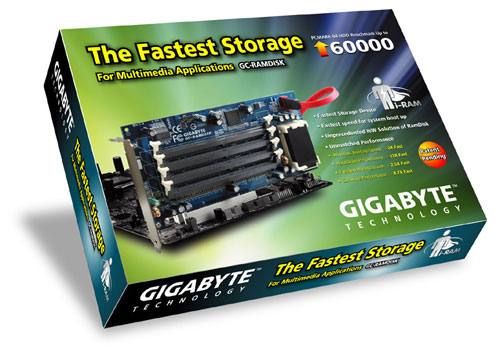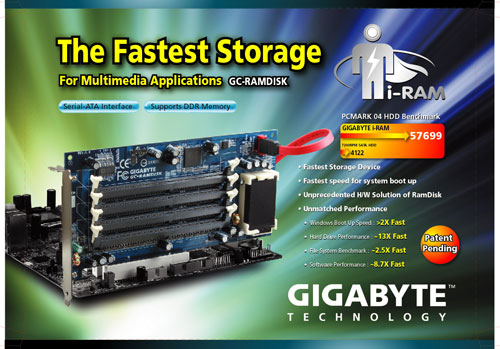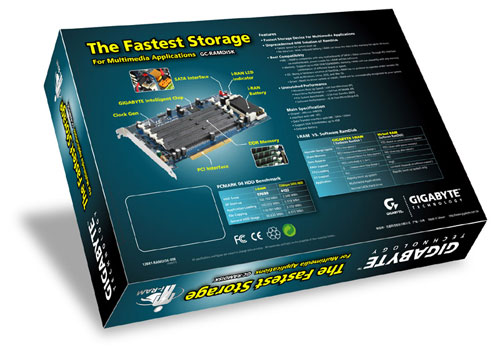Gigabyte's i-RAM: Affordable Solid State Storage
by Anand Lal Shimpi on July 25, 2005 3:50 PM EST- Posted in
- Storage
For years now, motherboard manufacturers have been struggling to find other markets to branch out to, in an attempt to diversify themselves, preparing for inevitable consolidation in the market. Every year at Computex, we'd hear more and more about how the motherboard business was getting tougher and we'd see more and more non-motherboard products from these manufacturers. For the most part, the non-motherboard products weren't anything special. Everyone went into making servers, then multimedia products, then cases, networking, security, water cooling; the list goes on and on.
This year's Computex wasn't very different, except for one thing. When Gigabyte showed us their collection of goodies for the new year, we were actually quite interested in one of them. And after we posted an article about it, we found that quite a few of you were very interested in it too. Gigabyte's i-RAM was an immediate success and it wasn't so much that the product was a success, but it was the idea that piqued everyone's interests.
Pretty much every time a faster CPU is released, we always hear from a group of users who are marveled by the rate at which CPUs get faster, but loathe the sluggish rate that storage evolves. We've been stuck with hard disks for decades now, and although the thought of eventually migrating to solid state storage has always been there, it's always been so very distant. These days, you can easily get a multi-gigabyte solid state drive if you're willing to spend the tens of thousands of dollars it costs to get one; prices actually vary from the low $1000s to the $100K range for solid state devices, obviously making them impractical for desktop users.
The performance benefits of solid state storage have always been tempting. With no moving parts, reliability is improved tremendously, and at the same time, random accesses are no longer limited by slow and difficult to position read/write heads. While sequential transfer rates have improved tremendously over the past 5 years, thanks to ever increasing platter densities among other improvements, it is the incredibly high latency that makes random accesses very expensive from a performance standpoint for conventional hard disks. A huge reduction in random access latency and increase in peak bandwidth are clear performance advantages to solid state storage, but until now, they both came at a very high price.
The other issue with solid state storage is that DRAM is volatile, meaning that as soon as power is removed from the drive, all of your data would be lost. More expensive solutions get around this by using a combination of a battery backup as well as a hard disk that keeps a backup of all data written to the solid state drive, just in case the battery or main power should fail.
Recognizing the allure of solid state storage, especially to performance-conscious enthusiast users, Gigabyte went about creating the first affordable solid state storage device, and they called it i-RAM.
Through some custom logic, the i-RAM works and acts just like a regular SATA hard drive. But how much of a performance increase is there for desktop users? And is the i-RAM worth its still fairly high cost of entry? We've spent the past week trying to find out...
This year's Computex wasn't very different, except for one thing. When Gigabyte showed us their collection of goodies for the new year, we were actually quite interested in one of them. And after we posted an article about it, we found that quite a few of you were very interested in it too. Gigabyte's i-RAM was an immediate success and it wasn't so much that the product was a success, but it was the idea that piqued everyone's interests.
Pretty much every time a faster CPU is released, we always hear from a group of users who are marveled by the rate at which CPUs get faster, but loathe the sluggish rate that storage evolves. We've been stuck with hard disks for decades now, and although the thought of eventually migrating to solid state storage has always been there, it's always been so very distant. These days, you can easily get a multi-gigabyte solid state drive if you're willing to spend the tens of thousands of dollars it costs to get one; prices actually vary from the low $1000s to the $100K range for solid state devices, obviously making them impractical for desktop users.
The performance benefits of solid state storage have always been tempting. With no moving parts, reliability is improved tremendously, and at the same time, random accesses are no longer limited by slow and difficult to position read/write heads. While sequential transfer rates have improved tremendously over the past 5 years, thanks to ever increasing platter densities among other improvements, it is the incredibly high latency that makes random accesses very expensive from a performance standpoint for conventional hard disks. A huge reduction in random access latency and increase in peak bandwidth are clear performance advantages to solid state storage, but until now, they both came at a very high price.
The other issue with solid state storage is that DRAM is volatile, meaning that as soon as power is removed from the drive, all of your data would be lost. More expensive solutions get around this by using a combination of a battery backup as well as a hard disk that keeps a backup of all data written to the solid state drive, just in case the battery or main power should fail.
Recognizing the allure of solid state storage, especially to performance-conscious enthusiast users, Gigabyte went about creating the first affordable solid state storage device, and they called it i-RAM.



Through some custom logic, the i-RAM works and acts just like a regular SATA hard drive. But how much of a performance increase is there for desktop users? And is the i-RAM worth its still fairly high cost of entry? We've spent the past week trying to find out...










133 Comments
View All Comments
Icehawk - Monday, July 25, 2005 - link
Huh, if this was at the $50 price point it would be a bit more interesting.I didn't like the pagefile test - it made no sense at all. Of course going from say 4b RAM to 2gb + 2gb iRam isn't going to improve the system... You needed to test what JUST changing the pagefile from HD to iRAM does.What about a typical 1gb RAM setup that most of us use? I still hit the pagefile on occasion and I do have ~1gb of old DDR I could use. Load times? No, I'd like to know if it smooths out gameplay. I know Doom 3 hiccups on my machine due to disk accesses.
Otherwise this doesn't look like it makes a lot of sense in its current incarnation.
lewis71980 - Monday, July 25, 2005 - link
No mention of using JBOD instead of Raid 0.That way with 4 pci slots used up you could get 16gb.
Maybe that would be enough space to do some proper server / databases.
Use a pair of normal 80 IDE HDD for os boot in raid 1 with file backup, from the i Ram card.
Braxus - Monday, July 25, 2005 - link
Know the article says it doesn't support ECC memory but will it still take it and run in in non-ECC mode? Most mobos I believe can at least do this. What about registered memory? Got a couple sticks of 1GB DDR266 RECC memory I'd like to use!RMSistight - Monday, July 25, 2005 - link
I definitely won't purchase this product until they implement SATA-II at 300Gb/s. Why should I shell out $150 for SATA150 when my DFI LanParty Ultra-D can do 300.I even asked one of the product managers at the AMD tech tour. I don't see why they wouldn't do it since SATA-II is backwards compatible to SATA-I.
Hacp - Monday, July 25, 2005 - link
BTW I hate this new layout. i have to click it to read the next comment. Is there anyway to fix this? also the forums didn't get a makeover visual wise.LeftSide - Monday, July 25, 2005 - link
I wonder If the athlon x2 would have shown a diffrence in the multitaking tests, Instead of useing a fx57?Nanobaud - Monday, July 25, 2005 - link
If more benches are to be done, I would put in a suggestion to test some compile times. Then I guess you should compare it to boosting youe system memory and installing a RAM drive, but this could be more convenient if you have those old 256 / 512 MB memory sticks lying around.nBd
Sunbird - Monday, July 25, 2005 - link
I want to know how long it will take the I-RAM to drain a standard UPS if the PC is off but connected to said UPS?jkostans - Tuesday, July 26, 2005 - link
A while. You would have to find how much power is dissipated by the i-ram, then use the capacity of your UPS to get an exact number. I would go as far as to say maybe up to a month if you have a good ups.Zebo - Monday, July 25, 2005 - link
$600 for 4GB (read useless) drive that maybe is not much faster than two 73GB drives in RAID 0 for half price? Uh Huh. If they sell 3000 I'll be shocked.